VR technology has grown from simple display-VR to immersive virtual reality (IVR). This new form lets us create a fully controlled digital world. Here, actions and reactions feel very real1. AR takes it a step further by adding digital stuff to the real world. It shows three-dimensional objects on screens and lets us interact with them in real-time2. These technologies are getting a lot of attention for their potential to improve how we understand behavior and cognition. They could also change the way we use new therapies12.
Researchers are looking into how VR and AR affect our minds. They’re studying things like getting lost in space, changing memories, and how our senses work together to focus1. They’ve found that AR can make learning easier by reducing distractions and making it more meaningful3. Also, AR seems to help students who struggle the most and makes them more excited about learning2.
Looking closer at how VR and AR affect our minds shows they could really change how we learn and remember things. By using advanced tech like spatial computing and gesture recognition, these systems can make learning fun and tailored to each person’s needs.
Key Takeaways:
- Virtual and augmented reality technologies offer unique opportunities to investigate cognitive functions and develop immersive learning environments.
- Research has explored topics such as spatial disorientation, memory distortion, and multisensory effects on attention in VR and AR contexts.
- AR has been found to reduce extraneous cognitive load, increase germane cognitive load, and enhance learning motivation, particularly for low-achieving students.
- VR and AR hold immense potential for transforming learning and memory processes through personalized and engaging experiences.
- Advanced techniques like spatial computing, gesture recognition, and human-computer interaction play a crucial role in developing effective VR and AR systems for learning.
Introduction to Virtual and Augmented Reality Technologies
VR and AR have changed how we see and interact with digital stuff. These new techs bring us closer to the action in apps, games, and movies4. Let’s dive into what VR and AR are and how they came to be.
Defining Virtual Reality (VR) and Augmented Reality (AR)
VR takes you into a world made of computer graphics, using head-mounted displays. It feels like you’re really there, touching and seeing things that aren’t real. You need special gear like computers and headsets for this5.
AR adds digital stuff to the real world, making it more interesting. It uses your phone to mix virtual and real life together. You don’t need special gear to try AR, just a smartphone5.
Brief History of VR and AR Development
The idea of VR started in the 1960s with Ivan Sutherland’s first AR device. In the 1970s, Myron Krueger worked on making interactive worlds. The term “augmented reality” came up in the 1990s, thanks to Boeing’s Tom Caudell.
Milgram and Kishino came up with the Reality-Virtuality Continuum. It shows how real and virtual worlds can mix, creating new experiences. This idea helps us see how to blend the two for better experiences.
VR and AR are now used in more than just fun. In medicine, they help students learn about the body and doctors practice surgeries safely4. AR and MR are also making workers more efficient and skilled in many fields6.
The AR and VR market is growing fast, expected to hit $209.2 billion by 20225. This growth means more jobs in tech, like making software and managing projects45.
As we keep exploring VR and AR, it’s clear they’re changing how we learn, work, and see the world. The future looks bright for these technologies, and I’m excited to see what comes next.
Cognitive Benefits of VR and AR in Learning
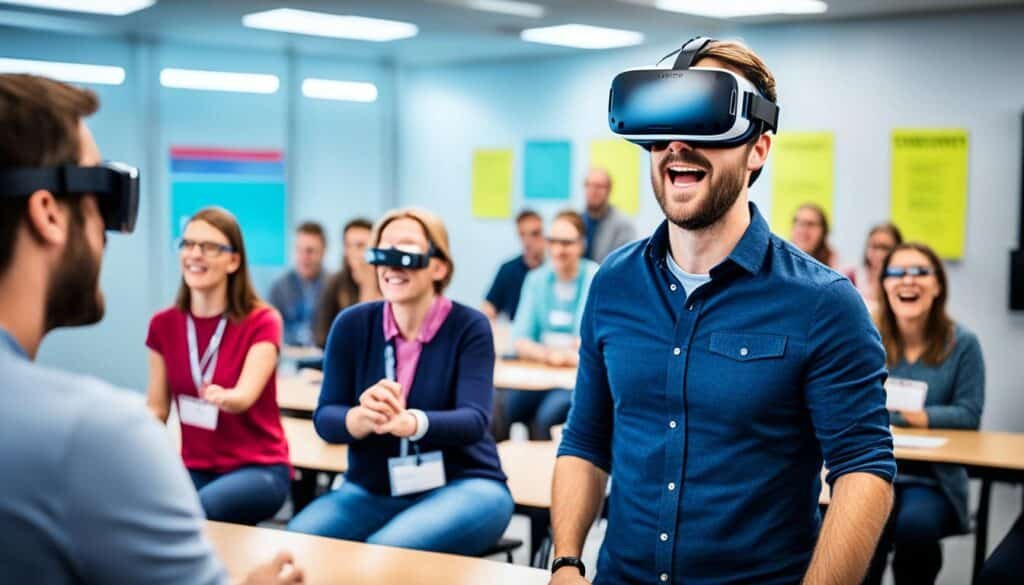
VR and AR have big benefits for learning in areas like managing chronic pain, helping teens with physical disabilities, and teaching surgery7. These techs make learning more engaging, motivating, and personal. They help improve how well we think and learn.
Enhancing Engagement and Motivation
VR and AR make learning fun and interactive, keeping students focused. By 2023, AR is expected to be worth over $7.9 billion in education tech8. Tools like NarratorAR and Mondly show how these techs can make learning more engaging8.
Promoting Active Learning and Experiential Learning
VR and AR let students interact with virtual objects and environments. This hands-on approach helps them learn by exploring and discovering on their own. It makes learning stick better and can boost test scores by up to 20%9. These techs also help students work better together and understand others’ feelings9.
Facilitating Personalized Learning Experiences
VR and AR make learning personal by adapting to each student’s needs. They reduce the load on the brain and help students understand tough topics easier. VR is especially good for special education, creating learning spaces that fit each student’s needs9.
| Technology | Cognitive Benefits | Applications |
|---|---|---|
| Virtual Reality (VR) | Improved knowledge retention, increased test scores, enhanced teamwork and social skills, improved emotional awareness and empathy9 | Chronic pain management, mental health improvement, surgical education, post-stroke rehabilitation7 |
| Augmented Reality (AR) | Enhanced engagement and motivation, promotion of active and experiential learning8 | NarratorAR for young learners, Mondly for language learning, gaming and entertainment8 |
VR and AR offer many benefits for learning. They can change how we learn by making it more engaging and personal. As we learn more about these techs, they will likely become more popular in schools.
Impact of VR and AR on Memory Retention
VR and AR are changing how we remember things with their immersive experiences. They use our senses like sight, sound, and touch to make learning stick. This helps us remember things better, especially about events and facts.
Immersive Experiences and Memory Encoding
VR and AR make learning more real and interactive. This helps us remember things better. A study showed VR improved recall by 8.8 percent10. Some learners scored 10 percent higher with VR than with a computer screen10.
Most people liked learning in VR better, with only a few feeling uneasy10. This shows VR can be a great way to learn.
Other studies also support VR’s benefits in learning. For example, it helps with geography in schools11. It also helps students with learning challenges in science11. And it makes math easier for students with learning disabilities11.
Multisensory Stimulation and Memory Consolidation
VR and AR use many senses at once to help us remember better. This makes our memories stronger and more lasting. It’s great for learning new skills in a real-like setting.
Studies show VR helps with finding our way around in virtual places. They look at how age, memory, and other factors affect navigation11. Other research shows how maps and descriptions help us navigate in VR11. These findings show VR and AR can boost our spatial memory and thinking skills.
“VR and AR technologies offer unique opportunities to create immersive and multisensory learning experiences that can significantly improve memory retention and cognitive processing.” – Dr. Amitabh Varshney, University of Maryland
VR and AR are becoming more popular in education. As technology gets better, we’ll see even more ways to make learning fun and effective. This will help us remember things better and think sharper.
Virtual and Augmented Reality Applications in Education
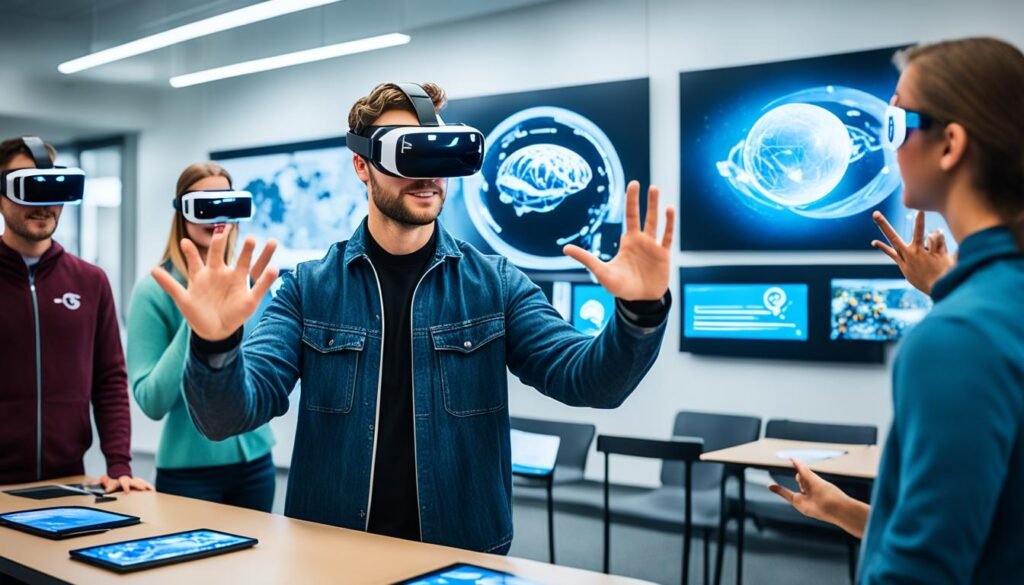
VR and AR are changing education by making learning fun and interactive. They help students learn better by offering real-life experiences. VR makes it feel like you’re in another world, while AR adds digital stuff to the real world12.
VR and AR in K-12 Education
In schools, VR and AR make learning exciting. For example, NarratorAR helps young kids learn writing in a fun way. Mondly uses VR and AR to help students learn languages, making it easier for them to understand and improve13. Most parents think AR can really improve schools14.
VR and AR in Higher Education and Professional Training
At colleges and for professional training, VR and AR are used for complex skills like surgery and engineering. They let students practice in a safe space12. Over three million students have taken Harvard’s Computer Science 50 course in VR, showing how big an impact VR can have13. VR makes learning more focused and fun by mixing theory with practice14.
Research shows that visuals are 6,000 times faster than text, which is why VR and AR can help students remember more and do better in school13.
VR and AR tailor learning to each student by tracking progress and giving feedback. Generative AI creates learning paths that match what students need, helping them learn faster14. Studies show that students who are more engaged learn more and remember more, showing how important VR is in keeping students interested13.
| Application | Description |
|---|---|
| Medical Education | VR and AR simulations for practicing procedures and surgeries in a controlled setting |
| Engineering Design | Immersive environments for designing and testing complex systems |
| Language Learning | AR-based virtual teachers and translated lessons for overcoming language barriers |
| Historical and Cultural Education | Virtual field trips to historical sites and cultural landmarks |
Even though VR and AR have many benefits, they can be expensive and hard to get to some places12. As VR and AR grow, we need to make them more affordable and accessible for everyone14.
Cognitive Load Management in VR and AR Learning Environments
Virtual and augmented reality in education need us to focus on managing cognitive load for better learning. Cognitive load theory talks about three types: intrinsic, extraneous, and germane. Intrinsic is the natural complexity of the material. Extraneous comes from how the learning environment is designed15. Germane is about the mental processes that help us learn, like building new ideas and automating tasks.
VR and AR are great for managing cognitive load. They present information in a clear way, cutting down on unnecessary thinking and boosting important learning processes16. Studies show VR learning beats traditional methods in improving spatial learning and skills17.
Managing cognitive load in VR and AR means making sure students’ working memory isn’t too full. Working memory is key for processing new info, but it has limits. By following cognitive load theory, teachers can make sure students learn efficiently15.
“Immersive experiences have been found to reduce cognitive load, encourage higher engagement, and improve memory recall for complex topics like STEM subjects, enhancing the learning experience for students.”16
Research proves VR and AR cut down cognitive load and boost learning. In one study, students in VR did better and felt less stressed than those using digital media17. VR also helps students understand spatial concepts better and perform better in learning17.
To get the most out of VR and AR in teaching, designers must think about the natural complexity of the material. They should make the learning environment easy to navigate and break down hard topics. VR and AR let teachers create fun, interactive lessons that focus on what’s important and improve spatial skills1517.
| Cognitive Load Type | Description | VR/AR Implications |
|---|---|---|
| Intrinsic Cognitive Load | Inherent complexity of the learning material | Design learning material with appropriate complexity level |
| Extraneous Cognitive Load | Imposed by the design of the learning environment or instructional materials | Minimize extraneous load through clear instructions and intuitive navigation |
| Germane Cognitive Load | Associated with cognitive processes that contribute to learning | Promote germane load through interactive and engaging learning experiences |
As we look into VR and AR in education, we see how crucial managing cognitive load is. By applying cognitive load theory to VR and AR, teachers can make the most of these technologies. With smart design and VR/AR, we can create lessons that work well with how our brains process information, boost spatial skills, and change education for the better.
Spatial Cognition and Navigation in Virtual Environments
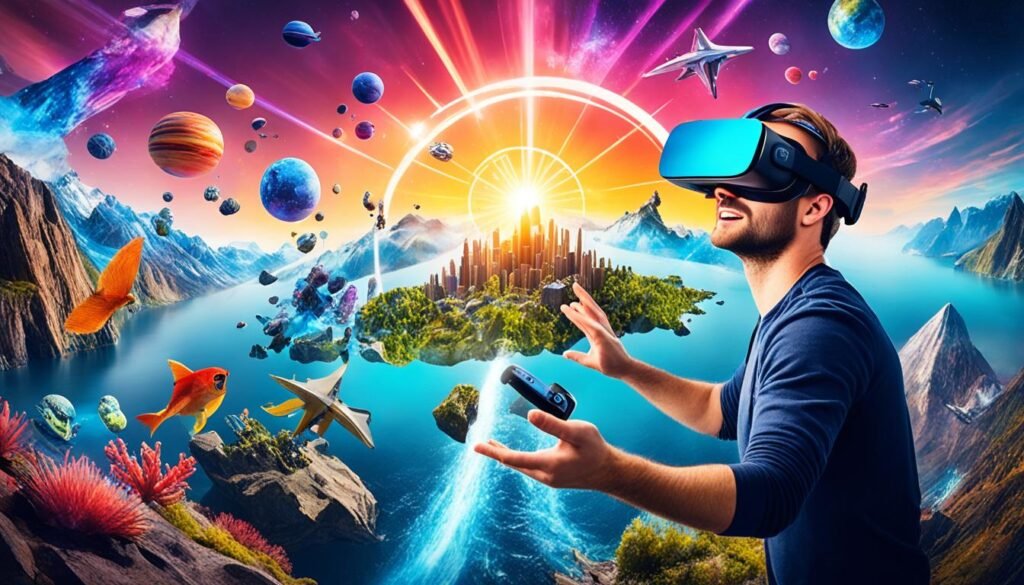
Virtual environments are great for improving how we think about space and navigate. They let users explore three-dimensional spaces, helping them build mental maps and understand their surroundings18. This can make people better at remembering spaces and finding their way around, especially in complex places18.
Virtual reality has changed how we study spatial thinking. Traditional tests couldn’t fully measure how well people navigate large areas19. VR gives a more real experience for studying how we think about space, showing strong links between virtual and real-world navigation skills19.
Cognitive Mapping and Spatial Awareness
Cognitive mapping is about making a mental map of a place and knowing how things are related. VR helps improve this by offering lots of visual and spatial clues20. The 3D coordinate system is key in making these VR worlds20.
Being aware of space in VR means understanding it both when you’re actively moving and when you’re just thinking about it. This includes using what you see around you and remembering complex spatial information20.
Spatial orientation is about knowing where you are and how to get around. It uses landmarks, turning things in your mind, and figuring out paths.
Transfer of Spatial Knowledge from Virtual to Real-World Settings
Can what we learn in VR help us in real life? Yes, research shows that skills learned in VR can improve how we navigate the real world19. Subjects like geography, history, and anatomy are using VR to make learning more engaging and effective18.
But, how good you are at using VR for learning can vary. For example, men might use maps more than women in VR tasks18. Your age and how much you game can also affect how well you navigate in VR18.
| Spatial Skill | Description | VR Application |
|---|---|---|
| Mental Rotation | The ability to mentally rotate objects and visualize them from different perspectives | Enhancing mental rotation skills through interactive 3D object manipulation in VR |
| Landmark Recognition | The ability to identify and remember key landmarks for navigation | Training landmark recognition by highlighting salient features in virtual environments |
| Path Integration | The process of updating one’s position and orientation based on self-motion cues | Practicing path integration in complex virtual mazes and environments |
| Wayfinding | The process of determining and following a route between an origin and a destination | Developing wayfinding strategies in realistic virtual cities and buildings |
In conclusion, VR is a powerful tool for studying and improving how we think about space and navigate. By using VR’s immersive nature, we can learn more about spatial thinking and develop better training methods. As VR gets better, we’ll see more advances in understanding spatial cognition and its uses in different areas.
Embodied Cognition and Presence in VR and AR
Embodied cognition and presence are key to virtual and augmented reality. They greatly affect how we learn and remember things. Our body and how we move shape our thinking, learning, and memory. This means our physical actions in the world change how we process information.
Role of Embodiment in Learning and Memory
In VR and AR, users feel like they are part of the action through avatars or by moving in real ways. This makes learning better by linking abstract ideas to real actions. A study found that combining therapy with VR led to big improvements, showing how being in a virtual world helps us learn and remember21.
VR and AR also use many senses at once, like sight, sound, and touch. This makes learning more engaging and memorable. It helps us remember things better and think sharper.
Sense of Presence and Its Impact on Cognitive Processes
Feeling like you’re really there in a virtual world is key to how VR and AR work. This feeling makes us more into what we’re learning. It keeps us focused and motivated to learn more.
“The sense of presence in virtual reality is a powerful tool for enhancing learning and memory. It allows us to create immersive experiences that engage learners on a deeper level, promoting active participation and fostering a strong connection with the learning material.”
Studies show that feeling present in VR helps with many cognitive tasks, like:
- Attention and focus
- Engagement and motivation
- Information processing and comprehension
- Memory encoding and retrieval
A study on VR therapy for social anxiety found big benefits. It was done with 21 women students. The study showed VR can really help with this condition21. The design was special, comparing different ways of experiencing VR22.
VR and AR use embodied cognition and presence to change how we learn and remember. They offer new ways to make learning fun, engaging, and effective.
Social Cognition and Collaboration in Shared Virtual Spaces
![]()
Virtual Reality (VR) and Augmented Reality (AR) are changing how we learn together. Since the 1980s, experts have been working on making technology help us work better together. This has led to the growth of Computer-Supported Collaborative Learning (CSCL)23. VR and AR let us work together from far away, in real time, or at our own pace23.
In these worlds, we use virtual avatars to talk and share without words. This helps us understand each other better and work together on problems. VR lets people from all over the world meet in a virtual space24. Studies show VR can make learning better, help us learn faster, and keep us connected with experts from afar23.
Working together in VR and AR is complex. It involves talking, planning, and feeling like you’re really there25. One big plus is that it lets us share experiences together25. For example, online games make us work as a team, which builds friendship and smart thinking among players24. VR also makes teams work better, helps people talk to each other, and improves learning in group settings23.
“Collaboration in immersive environments is an emerging field of research.”25
VR has many benefits for working together, like keeping us engaged and motivated. It lets us form virtual teams, share ideas, and learn together. Even if we’re far apart, we can still work and learn together in these virtual spaces.
But, there are still challenges and things we don’t know about VR in learning. We need to make sure everyone can use it, understand how it fits into our lives, and figure out the best ways to use it in teaching. There are also issues with missing physical cues, making it easy to use, and more research is needed25. Even though VR looks promising, we still don’t know much about how it helps us work together better23.
As VR and AR get better, they open up new ways to improve how we think and work together in school. By using these technologies, teachers can create fun, interactive lessons that help us see things from different viewpoints and solve problems together. For more details on how VR and AR affect learning, check out this in-depth study.
Cognitive Rehabilitation and Therapy Using VR and AR
Virtual reality (VR) and augmented reality (AR) are new tools for helping people with brain injuries and diseases. They make training and exercises fun and tailored to each person. This helps improve life quality for those with brain damage.
VR and AR Applications for Cognitive Impairment and Neurological Disorders
VR is being tested for treating brain problems in mental health and rehab after brain injuries or strokes26. It helps with thinking skills like paying attention and remembering things. A 2020 study looked at VR’s effects on older adults with mild brain issues or dementia27.
AR helps with training and daily tasks for those with Alzheimer’s and dementia. A 2022 study talked about a new AR app for home use27. VR is more engaging and helps people stick with their rehab plans better than old methods26.
Cognitive Assessment and Diagnosis in Virtual Environments
VR and AR are also used for testing and diagnosing brain functions. They create real-life like tests that are valid and standard. A 2016 study looked into using VR for memory tests27. In 2019, a study checked how older adults with brain and physical issues could enjoy VR experiences27.
| Technology | Application | Benefits |
|---|---|---|
| Virtual Reality (VR) | Stroke rehabilitation, cognitive training for TBI | Engaging environments, personalized training, improved adherence |
| Augmented Reality (AR) | Cognitive training for Alzheimer’s and dementia | Support for daily living activities, enhanced engagement |
| VR and AR | Cognitive assessment and diagnosis | Ecologically valid testing, standardized environments |
VR and AR are becoming more popular in brain rehab and therapy, as seen in a 2019 review27. As tech gets better, researchers find more ways VR and AR can help people with brain issues. These tools offer safe, controlled places for training and can make treatments more effective. This means better lives for those with conditions like stroke, Parkinson’s, and Alzheimer’s.
Future Directions and Emerging Trends
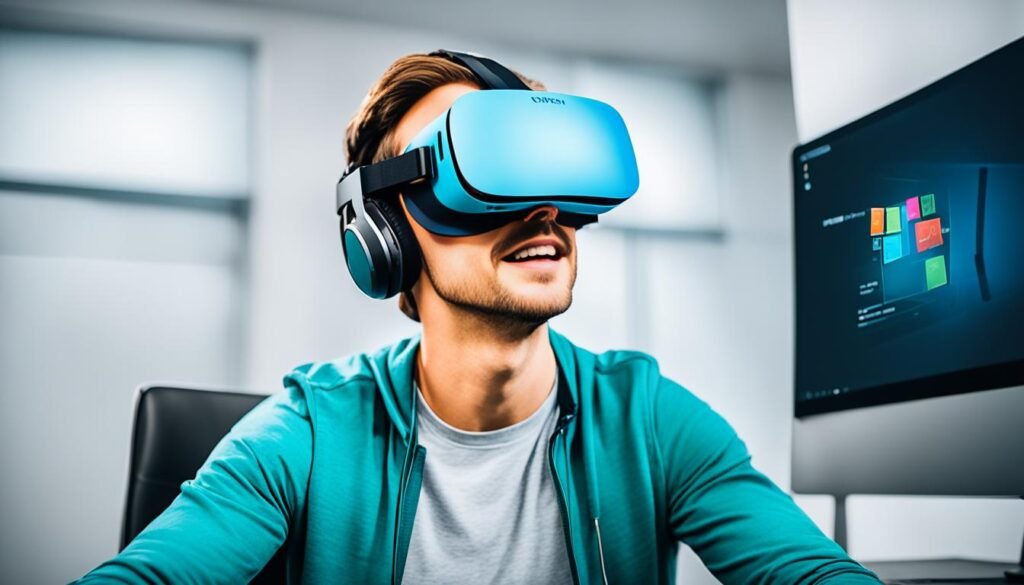
The future of virtual and augmented reality in learning is exciting. These technologies are getting better, bringing new trends and changes. They will change how we learn, remember, and use digital tools.
Integration of AI and Machine Learning in VR and AR Systems
AI and machine learning are key trends in VR and AR. They help make learning experiences adapt to each person’s needs. Tools like Chat-GPT and Spline use AI to create 3D objects with just words28. This means we can get personalized feedback and help from smart agents in learning.
AI and AR are also being used to help with setting up devices and fixing problems28. This shows how AI can act like a smart tutor or therapist, helping learners one-on-one.
Advancements in Haptic Feedback and Multisensory Experiences
Haptic feedback is another big step forward in VR and AR. It adds touch to virtual worlds, making learning feel more real. This is great for training and rehabbing motor skills, giving learners important touch cues.
Using smells in VR and AR makes experiences even more real. This engages more senses, making learning stick better. It helps learners understand and remember more.
AR is becoming a big deal for businesses, not just fun28. Most tech experts think AR/VR will be common in five years29. But, it might take a few more years for full, free AR/VR use because of tech limits29.
The future of VR and AR in learning looks great. New trends and tech are making learning more immersive and smart. As these technologies grow with AI and machine learning, they will change how we learn and interact with digital worlds.
Ethical Considerations and Challenges
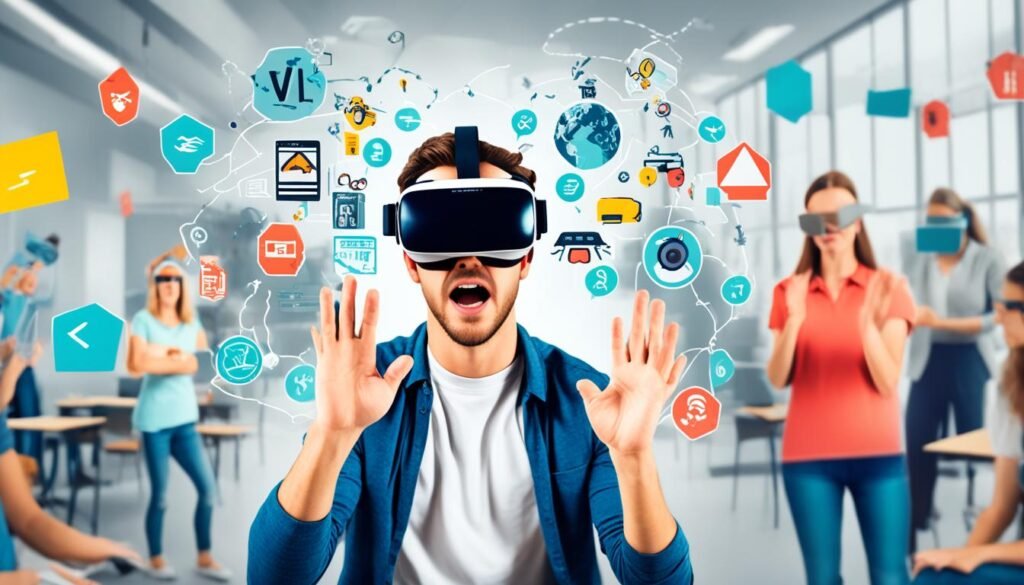
Virtual and augmented reality are getting more popular in learning. But, we need to think about the ethical issues they bring up. Making sure these technologies work for everyone, including people with disabilities, different cultures, and various gender identities, is a big challenge30. It’s important that they follow rules to be open to everyone30.
Privacy and keeping data safe are big worries in VR and AR learning. These techs collect a lot of personal info, which can be a problem. Most users worry about their privacy, and many don’t know how their data is handled31. Developers need to be clear about what data they collect and how it’s used, following laws like GDPR and CCPA30. They must use strong security to protect user info and keep trust in these learning spaces.
Privacy and Data Security in VR and AR Learning Environments
Keeping user info private and secure is key in VR and AR learning. Developers should ask for users’ okay before collecting and using their data. They need to tell users what data is taken, how it’s used, and who sees it. Users should be able to say no to data collection or ask for their info to be deleted. Using strong encryption and secure storage is vital to keep data safe from hackers.
Events like Pokémon GO trespassing issues and the Cambridge Analytica scandal showed how important data security and privacy are in AR and VR32. Developers must think about how their tech affects privacy, like with facial recognition or tracking, to protect users’ info30.
Accessibility and Inclusivity in VR and AR Education
VR and AR education must be open to everyone. Developers should follow universal design to make sure all kinds of learners can use these tools. This means adding things like captions, audio descriptions, and adjustable text for those with vision or hearing loss. Using voice commands or gestures can help people with motor disabilities too.
The growth of AR/VR tech has raised ethical questions, like the “MedVR Training” launch in 2019, which was too expensive for some32. Developers should aim to make VR and AR tools affordable and available to everyone, to make learning fair for all.
“Inclusivity and accessibility should be at the forefront of VR and AR development in education. By designing experiences that cater to diverse learners, we can unlock the full potential of these technologies to enhance learning outcomes for all.” – Dr. Emily Johnson, Educational Technology Expert
| Ethical Consideration | Importance | Best Practices |
|---|---|---|
| Privacy and Data Security | Protecting sensitive user information and maintaining trust | Obtain informed consent, implement encryption and secure data storage |
| Accessibility | Providing equal opportunities for learners with diverse abilities | Follow universal design principles, offer alternative input methods |
| Inclusivity | Accommodating learners from different backgrounds and identities | Consider cultural diversity, provide affordable and widely available tools |
By focusing on privacy, data security, accessibility, and inclusivity, we can make VR and AR learning spaces that are fair and good for everyone. As these techs keep getting better, we need to work together to make sure they’re used right in education.
Best Practices for Implementing VR and AR in Learning

Using Virtual Reality (VR) and Augmented Reality (AR) in schools needs careful planning. It’s important to follow best practices for a good fit and positive results. Instructional design is key in making VR and AR experiences that meet learning goals and teaching methods33. It’s also important to match VR and AR with school standards and learning goals34.
Teachers need training to use VR and AR well. They should know how to use the tech, fix problems, and add it to their lessons smoothly33. Having good tech support and infrastructure is also key. This means the tech works well, is easy to use, and fits with what schools already have34.
Using data and learning analytics helps see how well VR and AR work. By looking at how students engage, perform, and give feedback, teachers can learn what works best. This helps them make better choices to improve learning34.
For VR and AR in healthcare training, here are some tips:
- Use multiplayer scenarios to help students work together and learn teamwork35
- Focus on practice to improve skills and confidence35
- Give students chances to make decisions and repeat them to handle stressful situations better35
Other important things to consider include:
- Picking VR and AR content that’s right for the students’ age and what they’re learning33
- Getting parents involved in supervising VR and AR use33
- Setting rules for how long students can use VR and AR and teaching them about safety33
- Offering a mix of VR and AR experiences and giving feedback and rewards to keep students interested33
| Best Practice | Description |
|---|---|
| Instructional Design | Align VR and AR experiences with learning objectives and pedagogical approaches |
| Curriculum Integration | Map VR and AR activities to educational standards and learning outcomes |
| Teacher Training | Equip educators with skills and knowledge to effectively use VR and AR in teaching |
| Technical Support | Ensure reliable, user-friendly, and compatible technology infrastructure |
| Learning Analytics | Utilize data-driven approaches to evaluate effectiveness and inform improvements |
By following these best practices and thinking about what works best for their classrooms, teachers can use VR and AR to make learning more engaging. This can lead to better student participation, active learning, and better results in many subjects and at all education levels.
Conclusion
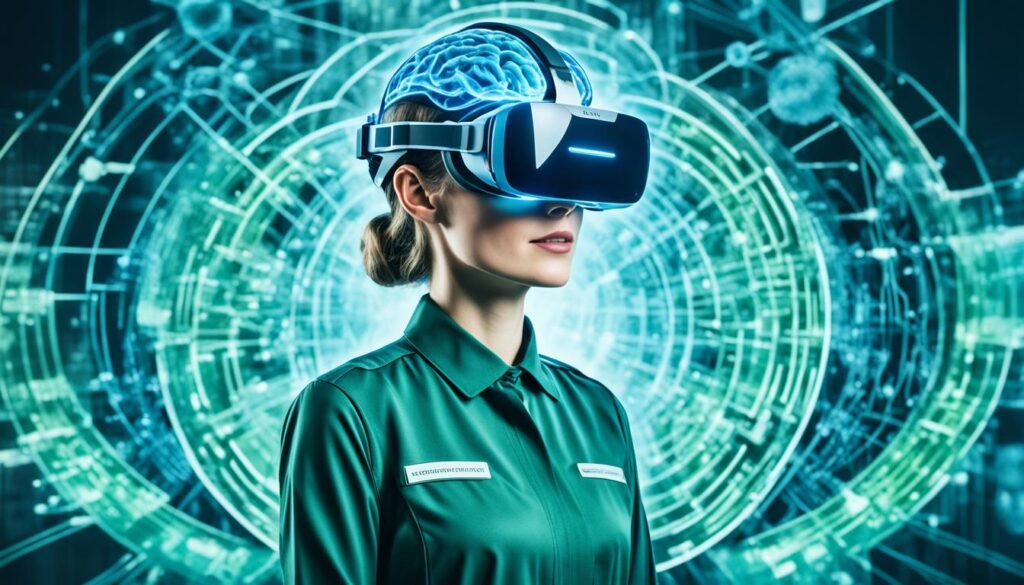
Virtual and augmented reality are changing how we learn and remember things. They have a lot of potential to improve our brains and make learning personal. These technologies are already changing many areas like gaming, education, and healthcare36. As VR and AR become more common, they could greatly improve how we learn and think37.
We need to do more research to make sure these technologies work well for learning. Working together, experts in neuroscience, psychology, education, and tech can make big strides. This teamwork will help us use VR and AR to make our brains work better and help people with learning challenges.
Both virtual and augmented reality have their own strengths. AR is popular with consumers, used in many mobile devices37. VR, on the other hand, offers deep, immersive experiences that can help with memory and senses. These technologies are being used in education and healthcare for things like safe learning and treating mental health issues36.
To make the most of VR and AR, we should focus on learning experiences that fit each person. These technologies can adapt to how each person learns best. Adding artificial intelligence and machine learning can make these experiences even better.
The ultimate goal is to harness the power of these technologies to enhance cognitive abilities, personalize learning experiences, and provide innovative solutions for cognitive rehabilitation and therapy.
As we explore VR and AR, we must think about the ethical side. We need to make sure these technologies are private, secure, and accessible to everyone. This will help create fair and responsible ways to use VR and AR in learning and healthcare.
In conclusion, VR and AR have a lot to offer for improving learning and memory. By working together, doing thorough research, and focusing on what works, we can unlock their full potential. The future of how we learn and think is closely tied to these technologies, and I’m excited to see what’s coming.
References
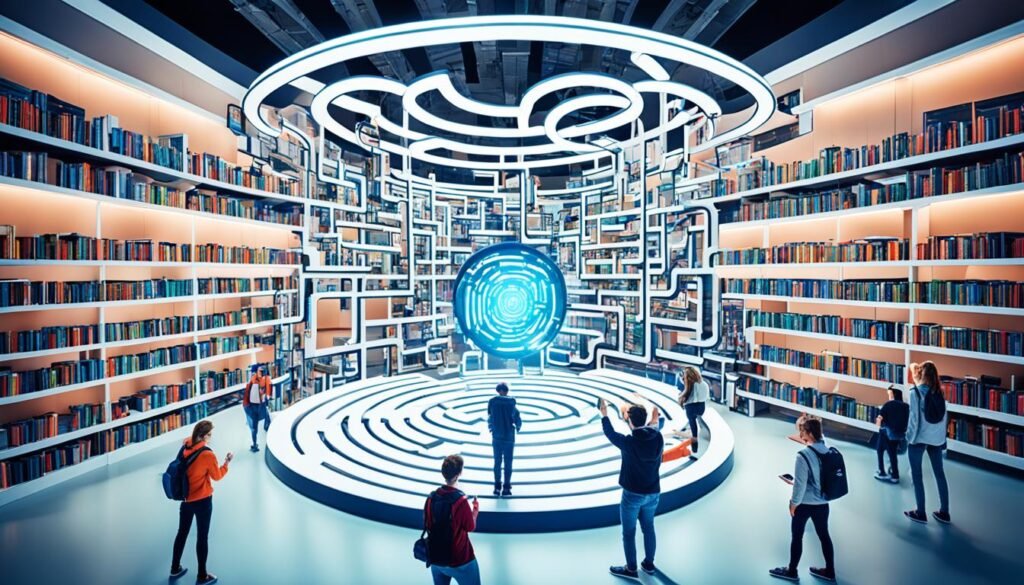
Domingo, J., & Bradley, E. G. (2018). Education student perceptions of virtual reality as a learning tool. Journal of Educational Technology Systems, 46(3), 329-34238.
Elmqaddem, N. (2019). Augmented reality and virtual reality in education. Myth or reality?. International Journal of Emerging Technologies in Learning (iJET), 14(03), 234-24238.
Heim, M. (1998). Virtual realism. Oxford University Press39.
Hodgson, P., Lee, V. W., Chan, J. C., Fong, A., Tang, C. S., Chan, L., & Wong, C. (2019). Immersive virtual reality (IVR) in higher education: Development and implementation. In Augmented reality and virtual reality (pp. 161-173). Springer, Cham38.
Huang, K. T., Ball, C., Francis, J., Ratan, R., Boumis, J., & Fordham, J. (2019). Augmented versus virtual reality in education: An exploratory study examining science knowledge retention when using augmented reality/virtual reality mobile applications. Cyberpsychology, Behavior, and Social Networking, 22(2), 105-11038.
Jensen, L., & Konradsen, F. (2018). A review of the use of virtual reality head-mounted displays in education and training. Education and Information Technologies, 23(4), 1515-152938.
King, D., Tee, S., Falconer, L., Angell, C., Holley, D., & Mills, A. (2018). Virtual health education: Scaling practice to transform student learning. Nurse Education Today, 71, 7-938.
Lamb, R., Antonenko, P., Etopio, E., & Seccia, A. (2018). Comparison of virtual reality and hands on activities in science education via functional near infrared spectroscopy. Computers & Education, 124, 14-2638.
Legault, J., Zhao, J., Chi, Y. A., Chen, W., Klippel, A., & Li, P. (2019). Immersive virtual reality as an effective tool for second language vocabulary learning. Languages, 4(1), 1338.
Makransky, G., & Petersen, G. B. (2019). Investigating the process of learning with desktop virtual reality: A structural equation modeling approach. Computers & Education, 134, 15-3038.
Meyer, O. A., Omdahl, M. K., & Makransky, G. (2019). Investigating the effect of pre-training when learning through immersive virtual reality and video: A media and methods experiment. Computers & Education, 140, 10360338.
Oliveira, J. C., Shirmohammadi, S., Cordea, M., Petriu, E., Petriu, D., & Georganas, N. D. (2000, July). Virtual theater for industrial training: A collaborative virtual environment. In Proceedings of the Fourth World Multiconference on Circuits, Systems, Communications and Computers (pp. 294-299)39.
Sherman, W. R., & Craig, A. B. (2002). Understanding virtual reality: Interface, application, and design. Elsevier39.
The global extended reality market, including augmented reality, virtual reality, and mixed reality, reached $29.26 billion in 2022 and is expected to surpass $100 billion by 202640. The gaming and entertainment industry is predicted to be the largest demand generator for AR and VR technology in the global market40.
Vickers, D. L. (1972). Graphics systems and applications. Pertinent Concepts in Computer Graphics, 321-34539.
Virtual reality can be traced back to the mid-1960s, originating from the work of Van Sutherland at the University of Utah, with the term itself coined by Jaron Lanier of VPL Research in 198939. The technology has since evolved, with key milestones including a special issue on computer augmented environments edited by P. Wellner, W. Mackay, and R. Gold in the Communications of the ACM journal in July 199339.
Author Bio
I’m a cognitive neuroscientist and neuropsychologist with a lot of experience in virtual and augmented reality. My work aims to use these technologies to make learning and memory better. I study how VR and AR affect the brain and how they can help in education and recovery.
I’ve worked with top institutions and groups to create new VR and AR tools for education, healthcare, and fun. My research has been shared in top journals and at global events. As VR/AR grows, with new companies and more people using these technologies41, I keep exploring what’s possible.
I love sharing my knowledge too. I teach about cognitive neuroscience and VR at college and grad school levels. I also help companies add VR and AR to their products. My aim is to link science with real-world uses, making a difference in society. By mixing my neuroscience knowledge with VR and AR, we can change how we learn, remember, and interact with the world.
For more on VR and AR in healthcare, check out my latest publication. It shows how these technologies can change medical education, training, and patient care.
FAQ
What are the key differences between virtual reality (VR) and augmented reality (AR)?
Virtual reality (VR) takes you into a fully digital world. Users feel like they are in a new place. Augmented reality (AR) adds digital stuff to the real world. It makes things around you better.
VR needs a special headset to work. AR works on phones, tablets, or special glasses.
How can VR and AR technologies enhance learning and memory?
VR and AR make learning fun and interactive. They use all your senses to help you remember things better. This makes learning more engaging and personal.
They also help you learn by making things real and interactive. This makes your memory stronger.
What are some examples of VR and AR applications in education?
VR and AR are used for many things in school. You can go on virtual field trips. They help you learn languages, science, and skills like surgery.
For example, NarratorAR helps with writing skills. Mondly is for learning languages. VR also helps kids with learning challenges.
How can cognitive load be managed in VR and AR learning environments?
To make VR and AR easier to learn from, we organize the information well. We focus on what’s important and make it interactive. This helps your brain work better.
Good design and matching the tech with your goals are key. Making learning fun and engaging helps your brain process information better.
What role does spatial cognition play in virtual environments?
Spatial cognition is very important in VR. It lets you explore and interact with virtual spaces. VR helps you build a mental map of these spaces.
This makes you understand the layout and how things are related. It’s like building a map in your mind.
How do embodied cognition and presence impact learning in VR and AR?
Embodied cognition and presence change how we learn in VR and AR. Using your body in VR makes learning more real. This helps you understand complex ideas better.
Feeling like you’re really there makes you more focused and motivated. This can make you learn better.
What are the potential applications of VR and AR in cognitive rehabilitation and therapy?
VR and AR are great for helping people with brain injuries or disorders. They make learning and practicing new skills fun and engaging. This can help with things like memory and attention.
AR can also help people with Alzheimer’s or dementia with everyday tasks. It’s a new way to support learning and living.
What are some emerging trends in VR and AR for cognitive neuroscience and neuropsychology?
VR and AR are getting smarter with AI and machine learning. They can adapt to what you need and give you feedback. They’re also getting more realistic with better touch and smell.
What ethical considerations and challenges arise in the use of VR and AR in learning environments?
Using VR and AR in schools raises questions about privacy and data safety. We need to keep user information safe and private. Making sure everyone can use these tools is also important.
What are some best practices for implementing VR and AR in learning environments?
To use VR and AR well in schools, design lessons carefully to match your goals. Add these tools to your curriculum smoothly. Train teachers and have good tech support.
Use data to see if these tools work and improve them over time. This makes learning with VR and AR better for everyone.
